Electric guitar bridges may just be the most unsung of all heroes when it comes to structural components. Not only can they provide aesthetic benefits, but they are the primary conduit between the strings and the body of the guitar. In short, the bridge has the primary responsibility of transferring the vibration of the strings to the body, creating the resonance and sustain that gives an electric guitar character, soul, life.
Just like any other major guitar component, though, bridges attract big opinions, some more objective than others, about tone, reliability, tuning stability, intonation, and ease of use. There are pros and cons to each type of bridge, and we’re here to help you cut through the conjecture and figure out which type of electric guitar bridge is best for you and your style of play.
In this KillerGuitarRigs Guide, we’ll be walking you through all of the different kinds of electric guitar bridges available today, from simple hardtails, through to high tech tremolo systems and locking bridges. Our aim is to help you understand what kinds of bridges are available, how they work, and what the best applications are for each.
Keep on reading if you’re looking to learn more about electric guitar bridges!
Contents
What Electric Guitar Bridge Is Best?
As we find with most electric guitar equipment, people often want to know which electric guitar bridge is best. Unfortunately, the answer (as usual) depends on several factors, including the style of music you play, the type of guitar you prefer, your experience level, and the aesthetic you want your guitar to have.
Of course, within the actual styles of electric guitar bridges, some are superior to others. An American Fender 2 point Synchronized Tremolo is far superior to the stamped pot metal 6 point system you’d find on something like a Squier Bullet series (or similar) guitar.
Better quality bridges, in general, improve tuning stability, tone, resonance, sustain, and intonation amongst other things. As we describe each type of bridge, we’ll give a couple of recommendations for quality options for you to choose from.
Fixed Bridges vs. Tremolo Bridges
While tons of different electric guitar bridges are available from dozens of manufacturers, they can be broadly grouped into 2 categories – fixed or tremolo.
Fixed Bridges

Hardtail bridges are fully affixed to the body of the guitar. They do not move and tend to provide the best resonance, sustain, and tuning stability. The downside of fixed bridges is that they don’t allow for as much playing expression.
Some commonly found fixed bridges include:
- Standard hardtails
- Tune-O-Matic Bridges
- Wraparound Bridges
- Evertune Bridges
Tremolos/Floating Bridges

Before explaining what tremolo bridges are, we’ll clear up one of the biggest misnomers in the entire guitar business. The effect that tremolo bridges make is actually vibrato, not tremolo. Tremolo is an undulating change in volume, whereas vibrato is an undulating change in pitch.
Tremolo bridges allow for extremely expressive playing, and are popular in genres like surf rock, and in hard rock and metal, where “dive bombs” are frequently played.
Some commonly found tremolo bridges include:
- Fender-style synchronized Tremolo systems
- Floyd Rose/Kahler style tremolo systems
- Bigsby style tremolos
- Maestro vibrolas
- Stetsbar style tremolos
Fixed Bridges
While fixed bridges are (usually) much simpler than their floating counterparts, they deliver big in terms of reliability and sustain. They’re more affordable, easier to adjust, and much more straightforward to maintain, making them a great choice for beginners and advanced players alike.
Standard Hardtails
The standard hardtail is most commonly found on Stratocaster and Telecaster style guitars, although it’s pretty popular on shredders, too. Hardtail bridges like these are screwed down to the body and sit flush. There are no routes or cavities behind them – this makes them incredibly secure, resulting in fantastic tuning stability. This stability is even further enhanced if a hardtail bridge is paired with locking tuners.
Strat Style
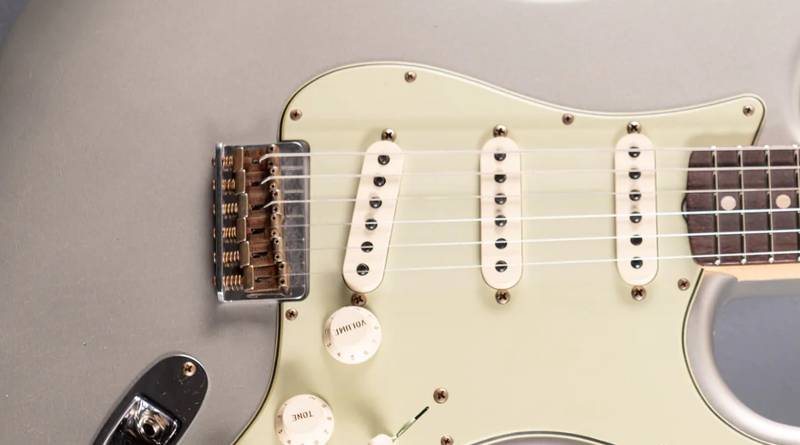
The Stratocaster-style hardtail bridge is very compact. It has a small base plate that houses the saddles and not much more. The standard design has individual saddles for each string, all of which are easily adjustable for both action height and intonation. Depending on the guitar, these saddles are either top loaders (set up for the ball end of the string to sit in the back of the saddles), or particularly in the case of shredders and super Strats, the guitars have “string-through” bodies, so the strings are fed through holes in the back of the guitar, and wrapped over the saddles from there.
Tele Style
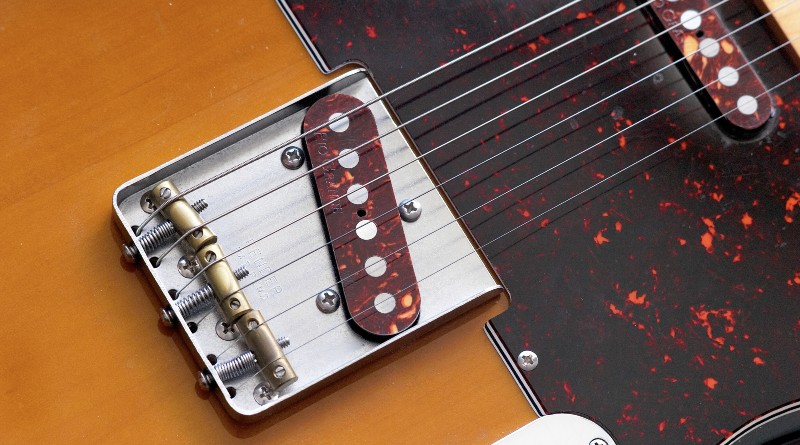
Telecaster-style bridges are much more unique and have a large metal base plate to which the bridge pickup is directly mounted. This is widely considered to be the ultimate source of the Telecaster’s signature twang. Classic Tele bridges feature three barrel style saddles, which are notoriously difficult to adjust. More modern Tele-style bridges come with six individual saddles, much like Strat-style examples, which drastically improves tuning stability and intonation but, according to some, loses the mojo.
Classic Tele-style bridges tend to be set up for string-through bodies, but especially on budget models, you’ll find that they are top-loading.
One major drawback to all Fender style hardtail bridges is that because they need to sit flat on the body, they are only compatible with slab-style guitars.
- Fantastic tuning stability and reliability
- Low maintenance
- Inexpensive
- Don’t fit on archtop guitars
- Adjustment screws can be easily lost
Tune-O-Matic Bridges
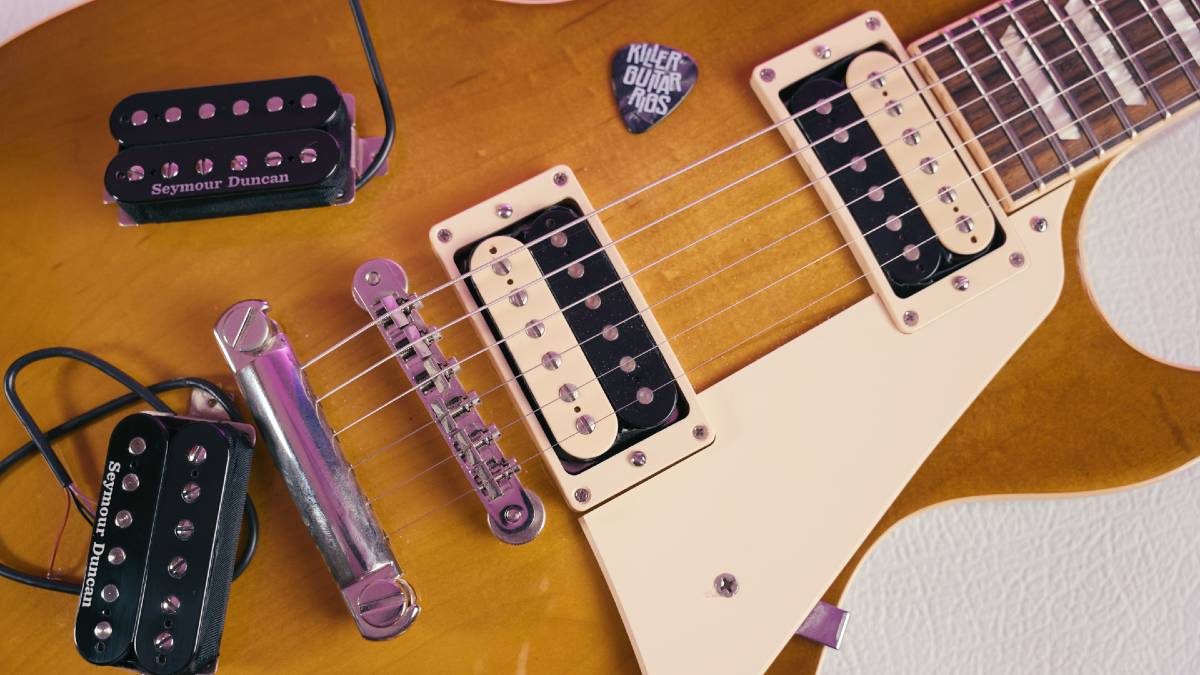
Tune-O-Matic bridges came along in the 1950s (1952 to be exact) as a new invention on the first Les Paul Custom. The intent of this design was to improve the break angle and increase the length of the string for better tuning stability.
Not only does having longer strings improve the tuning stability, but it also allows for greater intonation adjustment than a standard stop bar bridge. Action height is altered by way of adjustments to the bridge posts, and intonation is adjusted by moving the saddles either towards the headstock or towards the bridge. The downside of this setup is similar to that of a traditional three saddle Tele style hardtail insomuch as it is difficult to make fine adjustments, especially to action height.
An additional drawback of the Tune-O-Matic bridge is that it is very difficult to pair it with a fretboard with less than a 12” radius, so if you’re primarily a rhythm player, this might limit your options.
- Lots of sustain
- Accurate intonation
- Easy to add Bigsby or Maestro trem/vibrola
- Only works with flat (12”+) radii
- Difficult to accurately adjust action
Wrap Around Bridges
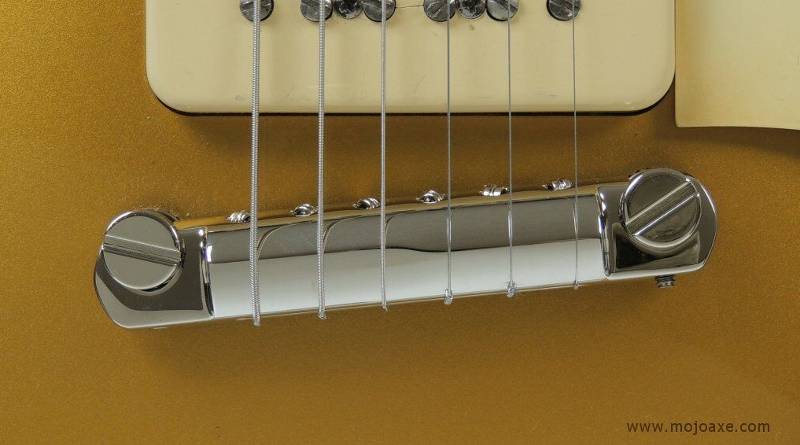
The wrap around bridge was the original electric guitar bridge. It’s possibly the simplest design of all, and is named because the strings are literally wrapped around it. There’s pretty much nothing that can go wrong with this type of bridge, making it a super reliable choice for everyone from beginners to pro players.
The obvious drawback to this simplicity is that there are few options for setup adjustments. They often have something resembling an acoustic guitar’s compensated saddle built into the top to help with intonation. However, further adjustments can only be made by making fine adjustments to the angle of the bridge itself using the bridge post screws. This makes it impossible to adjust just one string. The same goes for action height adjustments, which, again, can only be made by raising or lowering the bridge post height. This means that adjusting for one string will affect all of the strings.
It should be mentioned that there are some aftermarket wraparound bridges available that offer individual string adjustment, but due to the lack of break angle, the effect isn’t as noticeable as it would be on a Tune-O-Matic.
- Easy restringing
- Simple design
- Reliable
- Difficult to adjust intonation
- Limited setup adjustment range
Evertune Bridges
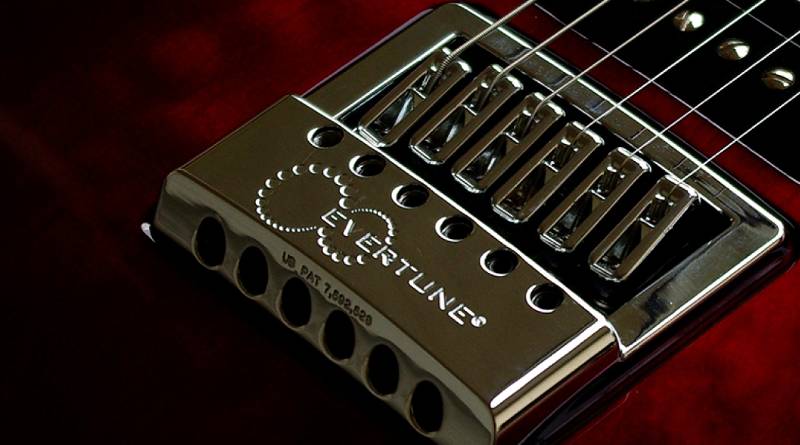
Evertune bridges are probably the most complex of all the fixed bridges. They belong to the hardtail family and are really starting to gain traction with mainstream manufacturers. They offer similar, perhaps even superior, tuning stability to locking systems and maintain pitch no matter how abusive you are to your strings.
These bridges house a floating saddle system with individual modules for each string, with a spring that counterbalances the tension of the string (in much the same way as a floating tremolo). The result is a bridge that allows for incredible tuning stability in any environmental condition, and no matter how hard to bend the strings.
- Unparalleled tuning stability
- Discreet aesthetics
- Difficult to install as a retrofit
- Expensive
Tremolo Bridges
As we mentioned earlier, it’s worth remembering that tremolo bridges don’t actually do tremolo; rather, they create a vibrato effect (this is why the Maestro Vibrola is much more appropriately named than the Fender Synchronized Tremolo!).
Tremolo bridges offer guitarists a lot of expressive possibilities in their playing, from the surf rock styles of the ‘50s and ‘60s to the heavy metal divebombs of the ‘80s and beyond. Things have come a long way since the first systems made their appearances, although some of the original tremolo bridges are still available, virtually unchanged, today.
Fender Style Synchronized Tremolo Bridges
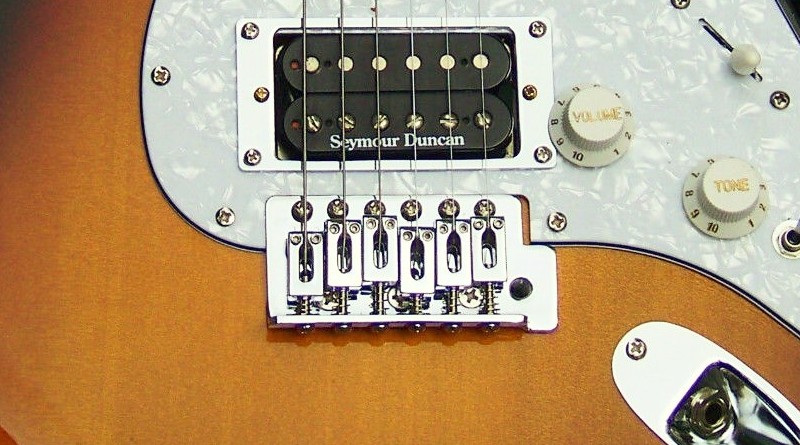
Just as the Stratocaster is one of the most widely copied guitars in the world, the Fender Synchronized Tremolo may well just be the most copied tremolo bridge system in the world. These bridges are attached to the body with either 6 (vintage style) or 2 (modern style) screws, but unlike hardtails, they aren’t fully secured; in this case, the bridge pivots on the screws.
The unit attaches to the guitar’s body with six steel wood screws. So the bridge can pivot smoothly about the screws, the upper portion of each one is unthreaded, they are not tightened all the way, and they pass through slightly oversized holes in the plate at the center of the design.
Like a Fender style hardtail, synchronized tremolo systems consist of a bridge with six individual saddles for each string, allowing for accurate intonation adjustments. What separates these bridges from hardtails, however, is that they are attached to a spring loaded vibrato unit. The string tension is counterbalanced by a system of springs that reside in the rear cavity, resulting in a full floating bridge (differing from the Evertune system in which only the individual strings “float”). This allows the player, by way of the tremolo arm (sometimes called the whammy bar), to quickly slacken and tighten the strings, resulting in a vibrato effect.
This system was testament to Leo Fender’s engineering know how. He took inspiration from earlier systems like the Vibrola, and made something that was easier to use, more effective, and generally more reliable.
- Easy for beginners to manage
- Lots of aftermarket support
- Systems vary wildly in quality
- Not as stable as locking tremolo systems
Locking Tremolo Bridges
Locking tremolo systems were invented to solve the reliability issues posed by previously available setups like Bigsbys, Synchronized tremolos, and Vibrolas. The Floyd Rose Locking Tremolo System was the first of its kind, invented in 1970 by Floyd Rose, an engineer and guitar player.
Like the synchronized tremolo systems, these systems make use of a spring setup combined with tension adjustable screws that counteract the tension of the strings. Again, like synchronized systems, the entire bridge moves when the whammy bar is manipulated, but the key difference is that they feature a locking nut, which firmly clamps down on the strings and maintains their length, which drastically improves tuning stability, even with downright abusive use.
Floyd Rose

As mentioned earlier, the Floyd Rose system was the first successful locking tremolo bridge. They are similar to the standard synchronized tremolo insomuch as they rely on the fulcrum pivot principle, and the bridge plate itself makes contact with the body via the pivot screws.
Floyd Rose systems, while widely available and demonstrably more reliable than standard tremolo bridges, are notoriously difficult to manage and maintain. If a single string breaks, it can throw out the tuning on the rest of the strings, and although once set, the tuning stability is excellent, restringing can be very challenging.
Regardless of the maker, locking tremolo bridges have had a huge impact on the guitar, and have allowed for the invention of entire new techniques and playing styles that were previously impossible to achieve.
Kahler
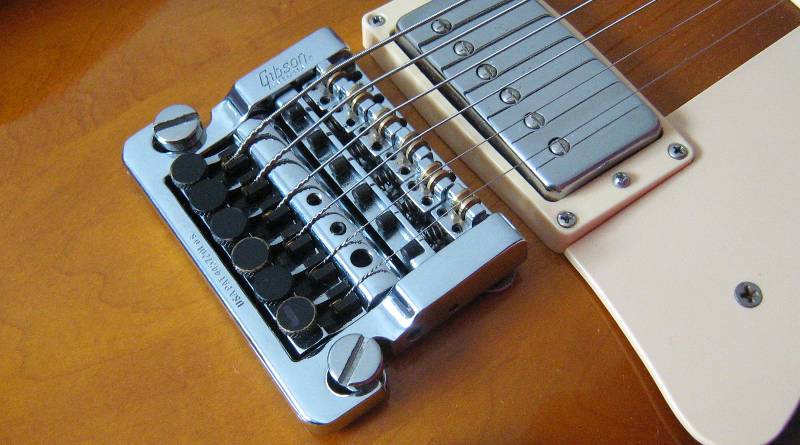
Kahler Tremolo Systems are the biggest competitor of Floyd Rose. They were invented by Gary Kahler, and while they also employ a floating bridge and locking nut setup, the mechanical arrangement is very different. Kahler bridges make use of a cam system instead of the knife edge fulcrum pivot used on the Floyd. This results in a much smoother action, with a wider range of motion.
Both the Floyd Rose and Kahler systems have had a profound impact on guitar playing, particularly within genres like rock, metal, and fusion where expressive pitch manipulation is a central aspect of the music. These systems offer players the ability to execute complex techniques and dive into musical passages that wouldn’t be achievable with standard tremolo bridges. However, they do come with a learning curve, as restringing and adjusting these systems can be more involved than with traditional bridges.
- Amazing tuning stability
- Allow for extreme playing techniques
- String changes are difficult
- Requires permanent modification to retrofit
Bigsby Vibrato Bridges

Bigsby (and Bigsby style) Vibrato bridges are super simple devices and were invented by (and named for) Paul Bigsby. He developed this vibrato system in the early 1950s, and despite the fact that it has been out engineered by much smaller, lighter, and frankly more reliable systems that have come along in the years since. One of the things we highlighted earlier in this guide was the fact that aesthetics plays a big part in bridge selection, and they don’t come much more stylized than the Bigsby!
There are no complex mechanisms involved with a Bigsby vibrato bridge. The only components are a tension bar, a spring, and the handle. Push down on the handle, and you’ll slacken the stings, lowering the pitch, and creating the vibrato effect when you push down and release.
One of the coolest things about Bigsbys (besides the retro look) is that they can very easily be retrofitted to just about any Tune-O-Matic type bridge, totally transforming both the looks and performance of the guitar.
The downside of course, is that in terms of tuning stability, they are at the weaker end of the scale. Fortunately, if you rarely use the system, it’s just about as reliable as a hardtail, but as soon as you go for that surf rock warble, you can kiss your pitch goodbye!
Vibrola Tremolo Bridges
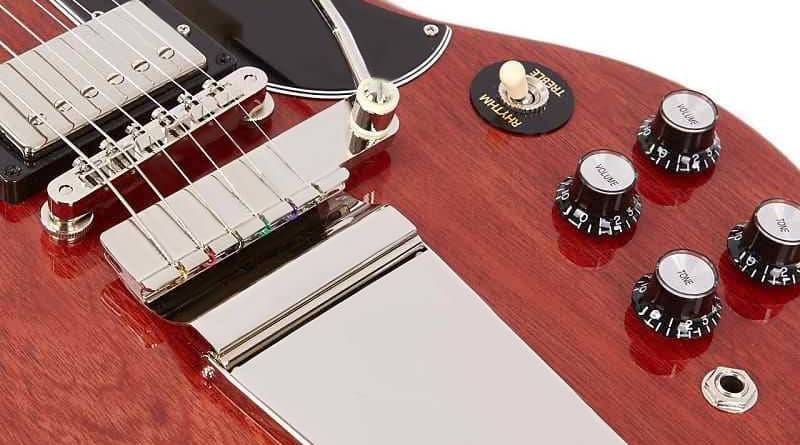
Vibrola bridges, most often fitted to ‘60s SGs are a Gibson design, and may just be the simplest of all tremolo/vibrato bridges. There isn’t a spring in sight, instead, there is a sheet of curved steel that the strings attach to, as well as the control arm. When the arm is manipulated, the steel plate flexes, and changes the tension on the strings, altering the pitch.
Like Bigsbys, Vibrola type bridges do have some limitations. They are extremely prone to causing issues with tuning with anything other than very light use, and the range of pitch modulation that they’re capable of is amongst the lowest of all the tremolo bridge types. It’s not all doom and gloom, though, as they do happen to be one of the sleekest looking systems around, and as long as you’re careful with how much pressure you apply, they deliver a really unique shimmery effect.
- Cool styling
- Super nice shimmer effect
- Heavy
- Easily loses tuning
Stetsbar Tremolo Bridges
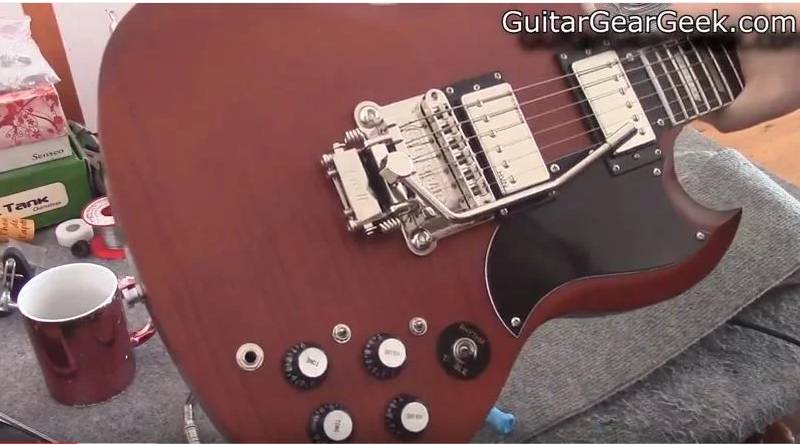
Stetsbar, like Floyd Rose, is a brand name that has become eponymous with a style of bridge. Les Pauls and similar archtop guitars have traditionally been limited to Bigsby-type tremolo bridges, but in 1995, Andy Stets invented the Stetsbar, which, while it has never been fitted to Gibsons as a stock bridge, is easily retrofitted without damaging the guitar itself.
These bridges have a unique design that attaches to the existing bridge post studs, making it super secure and simple to fit. They are, in effect, a floating tremolo system, but unlike most floating bridges, they work on the principle of a fixed pivot point, which drastically reduces the setup and adjustment difficulty, versus something like a Floyd Rose.
It can both increase and decrease string tension, which gives it a wide-ranging effect. The Stetsbar offers tuning stability similar to a well-set-up synchronized tremolo system but not anywhere near the kind of reliability you’d find on a Kahler or Floyd.
Aesthetically, it has a really unique look, with a handle that looks just like a Bigsby. There are a few versions available, with varying features on each, notably the Floating Lock system on the Pro II version, which maintains the tuning on the intact strings if one string snaps.
- Available for archtop and slab body guitars
- Easy to install
- Expensive
- Not aesthetically pleasing
Final Thoughts on the Different Kinds of Electric Guitar Bridges
As you’ve seen throughout this guide, there are a multitude of electric guitar bridge types, and within those categories, even more individual styles from different manufacturers. There are, of course, dozens, if not hundreds, of variations, so we focused primarily on the most popular types out there.
So, is there a best electric guitar bridge? We don’t think so. There are bridges that are better suited to certain styles and makes and models that happen to be better quality than others, but as always, your personal preference, including the style of music you play, your preferred aesthetic, and your budget, all have big roles to play in choosing a bridge for your electric guitar.


